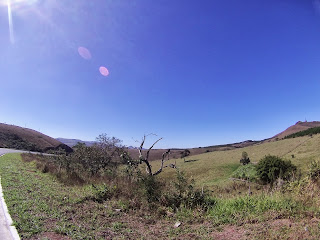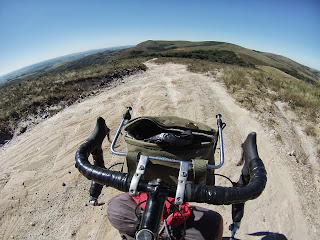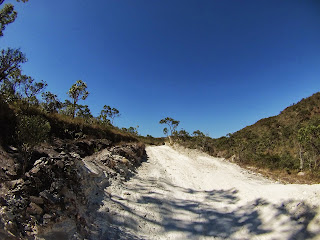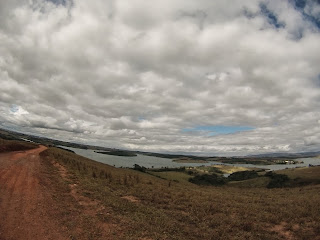In the morning I
said goodbye to Isabel and Jose Ado, the elderly couple at the Kamaam pension
who had treated me like a son. I asked them about the strange name, Kamaam.
Certainly not Portuguese, I said. It was an acronym of the names of the
children of Jose Ado’s siblings: Klebe, Auria, Marilio, Alexandra, Ana, and
Mauro (short for Jose Ado). As I left Isabel and Jose Ado gave me the strangest
gift: a huge, strange fruit picked from their back yard tree which looked like
a cross between an avocado and an artichoke but tasted like a banana, an
orange, a lime, and a pineapple, with seeds the size of a watermelon, tasting,
as a whole, like a lemon custard.
Rolling hills to Andrelandia. I wanted almoco there very badly but I knew I arrived too late. I stopped at a boteco where I thought I would drink a coffee or a juice and eat a salgado and then continue on to Sao Vincente.
When I entered the boteco there was a man in a Garmin cycling outfit. He asked me if I was travelling and I began to show him my bike and discuss my map and route. He had a bottle of beer in his hand and a glass and was with his son and had mountain biked with his son that day in the nearby hills.
We spoke for 30 minutes about my route and he gave me an alternative route to arrive in Carrancas, 50km across a dirt road with a steep 15km of climbing. The delay must have been long for him to bring his beer back across the street, as his father came across the street to fetch Fausto.
I was then invited to east almoco with his family in a beautiful home on the corner near the square. Inside were various family members, including his wife, his sons, his parents, and neighbors. Fausto was a cardiologist, perhaps my age, who lived in Sao Joao de Rei with his family. His wife was a carioca. We ate roasted chicken, pasta, cornmeal tort, fejoao com arroz, a zuchinni stew, and drank some beer. For desert I was served a sweet preserved lanranja, a green fruit concoction, and bread pudding.
Fausto’s friend Camilo arrived and animatedly gave me excellent advice over my route. Camilo knew the areas better than anyone I have encountered and I will follow his exact directions—mostly following the Estrada Real to Diamantina. According to Camilo, Januaria is the best place on earth, “o melhor lugar no mundo,” and my route will take me there. It is good now to have definition and to visit the best place on earth.
We drank a coffee together after dessert, I said goodbye to all the family members, got my bike from their garage, and hit on the road just before 4, and cycled 18km to Sao Vicente in 1.5 hours.
Looking for a room, I passed a large church in the center and peeked into a wedding. I found a room in town, then set off to the town square and found a jungle gym and did knee raises from the pullup position, dips, pullups, and tricep extentions. I hit up the grocery store for some provisions, and fell asleep in exhaustion.
The next morning I set off for Carrancas, finding the turnoff to the dirt road Fausto had recommended. I was met by green, rolling hills with grazing cattle, open fields, shaded forests, large birds of prey, huge ant mounds, steep climbs. The final 2 kilometers of climbing had to be close to a 20 percent grade, as I was in my lowest gear, out of the saddle, weaving back and forth across the road.
The next morning I set off for Carrancas, finding the turnoff to the dirt road Fausto had recommended. I was met by green, rolling hills with grazing cattle, open fields, shaded forests, large birds of prey, huge ant mounds, steep climbs. The final 2 kilometers of climbing had to be close to a 20 percent grade, as I was in my lowest gear, out of the saddle, weaving back and forth across the road.
I found a room in a pension run by Margarete and her young son, Nicolas. I was served a plate of beans, rice, chicken, greens, and salad for dinner, but they had no beer. I set off for a small place on the square and pulled up a stool and began to chat with the couple that ran the place. Astonishly, they had run out of cachaca, and were embarassed. I drank a quick beer and they pointed me to a bar, filled with men who were in their farm clothes, cowboy hats, rubber mud boots.
Everyone wanted to introduce themselves to me at once, so much so that I only picked out one name during the night, Alex, or Tatoo, a large farmhand who was visably drunk from cacacha and poured me several glasses of beer. I asked the men if the cachaca mineira was any good (firewater from Minas Gerais). Of course the cachaca was the best, they responded. I was given two doses of cachaca from large ceramic bottles, one yellow, one clear. The bartender held them up to the light to make sure he had got the colors right. I began to sip the yellow one—you sip cachaca slowly if you want to remember your name by the end of the night—when a man handed me a fried, salty chicken wing. He insisted I had to have something in my stomach.
As the night continued I noticed the men all had knives and large chords of tobacco from which they shaved the tobaco into small pieces of corn husks to make cigarettes. It was a very sweet mellow smoke and the men were impressed I didn’t cough.
Tatoo continued playing pool with his buddies—there was no cue ball, and scorekeeping was inventive and vibrant. I had a tough day of climbing ahead of me the next morning and I said farewell to the fellas at 10. Eight guys shook my hand and gave me hugs and told me to go with God.
The next morning I aimed to ride 75km to Tiradentes. The goal was to take a rest day in Tiradentes, ride back 13km with an unloaded bike to Sao Joao del Rei to see some sculptures and pay a visit to Fausto, and then return back to Tiradentes.
Instead, I road 28km over what was easily the toughest 28km of my touring. Departing at 11, arriving at Capela do Saco at 3:30, I was completely spent from climbing off-camber river beds, incredibly steep and sandy ascents, slippery, sandy rocky descents, most of it in intense sun. It was the path of the Estrada Real, an old diamond and gold route that connects Diamantina to Paraty, dating back to the 17th century. Like the Carretera Austral, much of the Estrada Real cuts through untouched beauty. Many sections require a 4x4. Many small creek crossings have cattle guards (“mata burro”) which run parallel to the road, requiring a full stop to cross.
I wanted to camp but I was out of food and there didn’t appear to be a grocery in Capela do Saco, a small village with a 23 families. The pousada in town was run by Debora and her mother and they treated me very well. They fed me a rich almoco of chicken stew with carrots, and dishes of cornmeal, rice, beans, green veggies, cabbage, orange rind dessert, pasta salad with bacon, and the preserved orange dessert. I ate a pickled seed which was as hot as a jalapeno.
I passed the night with a family from Sao Joao del Rei, Debora, and her mother, eating limes and drinking tequila. Debora was from Palmas, the capital of the state of Tocantins, a state created 23 years earlier, carved from the state of Maranhao. I saw photos of the large river Tocantins, which has a bridge that spans 8km across the damned river. Debora and her mother had lived in Tocantins for many years and had set off for a new life in Minas Gerais. Over the last 8 months—in Brasil, Paraguay, Chile, Argentina—I have heard the story of those seeking the more simple life from the big cities: Porto Alegre, Floripa, Coritiba, Sao Paulo, Rio, Encarnacion, Buenos Aires, Rosario, Cordoba, Mendoza, Santiago. At one point the cities bring many together, but then at another point people return to where there is more space, where the articulation of human conduct is affected less by the surplus of printing presses and more by the shape of the earth, the growth of crops, the care of animals, the unmanipulated nurture of families.
The next morning an old farmer appeared at breakfast, 82 years old, carrying his scathe and knife. He was looking for work. We spoke about the war between Paraguay and Brasil in 1945. I told him I had met many Brazilians in Paraguay and spoke Portuguese my first 2 days in that country.
Debora walked me to the home of the ferry driver to cross the Represa Camargo. The entire block of 8 homes were from the same family. I had met the man the day before as he was clearing grass with a scathe and he had pointed me in the direction of the pension. The three of us walked together to the boat and a car appeared and it boarded the ferry as well for the 800 meter trip across the represa to Caquende.
I rode 22km of very steep dirt roads in the sun and was spent when I reached Sao Sebestao da Vitoria. I hit pavement and rode another 30km to Tiradentes, a very old town that reflects the wealth of diamonds and gold from 300 years earlier. I was lucky the town was relatively empty, as I was able to find a cheap room. The next day my legs were shot and I knew I needed a full day of rest. I didn’t have it in me to ride to Sao Joao del Rei and return to Tiradentes. This made me slightly sad, as I would not be able to visit Fausto, but perhaps another time I shall return and ride with him in the dirt roads and rolling hills.
Salgado de frango
Isabel and Jose Ado
Short-necked buzzard sitting on a dead tree
Fausto. He and Camilo would chart my route in Minas Gerais. A great, great man, with great friends and family.
A the top of steep climb to Carrangas
Some cattle guards run parallel to the road.
Margarete's dinner.
Margarete's pension.
This and the next photos below are from Carrancas to Capela do Saco, a stretch of 28km that I consider among the most technical I've ridden. Off-camber river beds, huge, buckling rock formations, sand, loose rock. Not all the photos illustrate the conditions, as I only shot when I stopped.


Cue sheet I found buried in bag from December 2012.
Tiradentes
Igreja Santo Antonio, facade by Aleijadinho, an 18th century sculpture who suffered from leprosy and had no fingers.
Inside the church, 470 kilos of gold in the art.



















































































